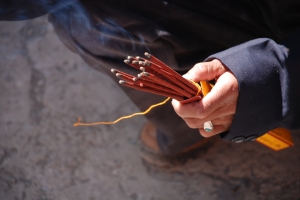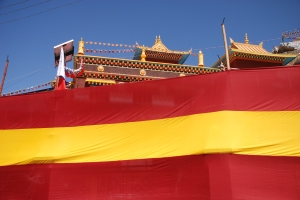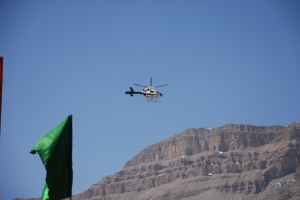It’s a mystery to me
We have a greed
With which we have agreed
When you think you have to want more than you need
Until you have it all you won’t be freed
Spiti Valley is a remote, almost isolated region in the north-east of the Indian state of Himachal Pradesh, about 100 km from the Tibetan border. The valley is quiet, road traffic is minimal and villagers live off the land and do not have much need to venture beyond their homes. The capital village (not city or town, but village) is sleepy Kaza. But for three days, Kaza was buzzing as His Holiness the Dalai Lama flew in for a visit.

Police officer keeping the peace
Security was very high and Indian police with their AK-47s were everywhere, amongst the crowds and perched on top of roofs nearby. One major downside to all this security was that no cameras were allowed into the gompa while HH Dalai Lama was there so I didn’t get any pictures of him.

Burning incense
He came to Kaza inaugurate the new gompa, to share some knowledge about emptiness and impermanence and to initiate those who wished to be into the way of Avalokitshevara, the Buddha of Compassion. The most recognized Buddhist mantra, “Om Mane Padme Om”, is a mantra from this Buddha that brings compassion to those who say the mantra.

Buddhist nuns awaiting His Holiness's arrival
Spitian culture and language is similar to Tibetan culture and language and the primary religion in the valley is Tibetan Buddhism. Not surprisingly, it seemed that every Spitian from the valley came to Kaza for these talks. Add to that a couple of hundred Westerners and you’ve got a village where all the hotels are fully booked and power outages are happening every night as the power grid in Kaza wasn’t designed to handle so many people.

Family waiting alongside the road
As we sat and listened to him talk, monks would be walking by serving butter tea and bread. If you’ve never had butter tea before then consider yourself lucky.

Welcome HHDL!
I met up with Tamsin in my shared jeep ride from Manali to Kaza, along with Marni and Lindsay, two sisters from the States, and Penpa, a 28 year old Tibetan guy who somehow is always smiling and laughing, and this after I’ve been traveling with him for a couple of weeks now.

Buddhist monk
Each morning around 7 a.m. a couple of us would head out early to the gompa (monastery) to try and save a few places for the group. Locals and Tibetans had the prime location right in front HH Dalai Lama while the foreigners were off to the side, with a good view of his left side. So many locals turned out that they began moving into the foreigners section and soon outnumbered all of us.

The main gompa
While we were waiting for the talks to begin, a monk was chanting “Om Mane Padme Om” rapidly and repeatedly over the speaker system. I thought there was a 50-50 chance he would achieve enlightenment that morning with the pace at which he was chanting.

His helicopter makes a loop overhead
But the best part about seeing HH Dalai Lama speak, even not understanding Tibetan, is just hearing his infectious laugh. It comes unannounced and can come at any time.

Monks and nuns line the street

Buddhist monk in traditional headdress
When all the pre-talking rites and rituals were completed, we sat down, opened up our notebooks and tuned our radios in to 97.9 FM. “Relax, enjoy the bread and enjoy the tea. And listen to me also. Heh heh heh.” And with that we began the teachings.
“What is I?”
“Does I have a beginning or not?”
“Does I have an end or not?”
Those were the questions he began with. He compared the answers to these questions as they would be answered from the perspectives of the different major religions in the world. At no point did HH Dalai Lama every claim that one religion was more correct than another, but instead encouraged people to follow the religions of our parents but with knowledge and harmony of other religions.
“What is I?” You can also ask “What is this computer?” The point of the exercise is to try and identify the one thing, one piece, that you can say “Aha, that is I, or that is the computer.” You’ll find you can’t.
Things come into existence through mere designation. Analyze any object and you’ll find that you can’t find it. Here is an example. Let’s say you’re taking a walk on a mountain. You pick up a beautiful rock, then you throw it into the river below.

Wake me up when he gets here
This is the foundation of emptiness, one of the final teachings of Buddhism. The notion of emptiness in Buddhism basically means that nothing in this world exists on its own, that nothing exists independently of anything else. We designate things as ‘a mountain’, ‘a car’, or ‘I’ because we have this notion of duality, that there is an independent I and each object we see is also independent. But this is a completely false view.
Take the computer you’re using right now as an example. It is made up of many parts, each of which was built and assembled by a machine or a person.

Monks and nuns lining up with their kattas
By the way I’m probably not doing justice to how HH Dalai Lama explained this and even as I’m reading through mine and Lindsay’s notes I’m having trouble explaining it, so apologies if this doesn’t make too much sense.

Buddhist monk
The other thing he spent a lot of time talking about was attachment and impermanence, that nothing in this world is eternal and yet we cling to everything as though they will last forever. We cling to our material possessions, our relationships and even more importantly, to our lives, as though we expect them to be here for all time. Another exercise he had us try was to find anything in this world that is impermanent, something that will never change.

Two young monks sharing some Fanta
Everything changes. That George Foreman grill you got for Christmas two years ago probably looks a lot different now than it did when you unwrapped it. And twenty years from now it’ll probably be in some scrap heap in New Jersey. Your new car is no longer new soon after you leave the lot. Nothing doesn’t change.
And from all of this we are to extrapolate that yes, even we, with these super duper bodies of ours are impermanent. Even with our Kirkland Signature daily-multi-vitamin supplements and Cod Liver fish oil tablets and our three-times-a-week gym routine, we’re still going to fade away.

Warming up the band
This is a really hard thing to do for many reasons. We live in a world where we are measured by the mountains of material possessions we have. We become so attached to these things and to the perception they help us project of ourselves to others that we fight tooth and nail to keep the things we have. If someone scratches your car door, steals your camera, spills your beer, blood pressure rises accordingly.
On a side note, there is something about long term traveling that makes you stop caring so much about your material possessions. I think it has to do with the fact that all of your belongings are in your backpack and so you end up having way less things than you would at home. And you begin to realize that you don’t really need so much to get by or be happy in this world (just an iPhone and some Indian curry is good enough for me). When you begin accumulating too many things, you can physically feel the burden of the extra weight on your back. At home you simply shove them into your storage closet that has become a veritable Jenga-game-in-waiting and forget about it.
There were three days of talks and I’ve only tried to capture the general idea of what he spoke about. It isn’t the hardest stuff in the world to understand but it is difficult to absorb and just writing it out here has been a good challenge in recalling everything we heard.
We did have one very curious happening. The day before the Avalokitshevara initiation we were given strands of kusha grass to place under our pillow and mattress at night. It was intended to keep away bad dreams and perhaps also give us pleasant dreams. The intention is to basically protect us during the couple of days of the initiation. The next morning as we were walking to the gompa, I asked Lindsay and Marni if they had any dreams. Marni, like me, hadn’t had any dreams that she could remember but Lindsay had a dream where she had visited many different Buddhist temples.
HH Dalai Lama began his talks that morning talking about the kusha grass and the interpretation of the dreams. The first thing he said was “If you had any dreams about visiting temples, then that is a good dream.” We were floored. This was exactly Lindsay’s dream. But before we could get too excited about it, he reminded all of us that “good or bad dreams, remember that they are gone now so don’t put too much importance on them.”
In other words, don’t get attached.
Well-said! I really enjoyed reading this post. I’ve been trying to maintain the perceptions I gained during our experiences in Spiti now that I’m back in the US, and it is becoming a challenge already. I think reading this helped. Funny side note: I’ve had “Society” playing in my head constantly for the last few days, and it often makes me think of you. It was cool to see those words at the start of your blog. 🙂
Hi Emile,
I loved reading this post. Very well done and great to hear your interpretation of him speaking. I remember when Joanna and I spent 6 months living in Italy and we had the exact same realization about “things”. We lived out of a suitcase and slept in bunk beds and had never been happier. There was no need for “stuff”. Having been back in the states for 6 years now, I always try to remember this but can’t say I have been completely successful. So this is a good reminder. I hope it always stays with you.
Love hearing about your experiences, keep it up!
All the best,
Suzannah
Lindsay thanks for taking such good notes. I would have forgotten half the stuff without them!
Suzannah, that’s great to hear about your and Joanna’s travel. I hope I can keep up the traveling ways and mindset when I’m done traveling. If I can’t, then maybe I’ll just have to keep traveling until I can. BTW welcome back to work. I read your newsletter last week 🙂